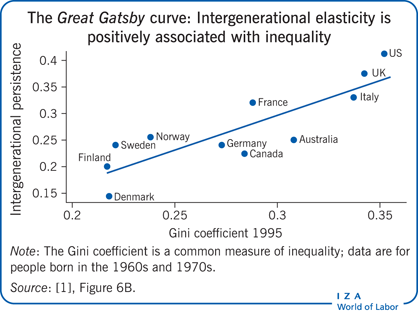Elevator pitch
A strong association between incomes across generations—with children from poor families likely to be poor as adults—is frequently considered an indicator of insufficient equality of opportunity. Studies of such “intergenerational persistence,” or lack of intergenerational mobility, are concerned with measuring the strength of the relationship between parents’ socio-economic status and that of their children as adults. However, reliable measurement requires overcoming important data and methodological difficulties. Moreover, the association between equality of opportunity and common measures of intergenerational persistence is not as clear-cut as is often assumed.
Key findings
Pros
Intergenerational income elasticity, a measure of inequality transmitted between generations, is related to a well-developed conceptual framework.
Comparisons of intergenerational income persistence across countries, localities, and time reveal settings where intergenerational links are weaker.
The impacts of poorly measured parental income on estimates of intergenerational elasticity are clearly understood.
Correlations between rank positions in the income distribution, which are unrelated to the particular distribution, may be a purer measure of persistence than elasticity. Researchers are developing other measures which can capture the size and direction of mobility.
Cons
Not all mechanisms driving intergenerational persistence are necessarily clearly related to fairness and equality of opportunity.
Data requirements for reliably comparing estimates of intergenerational mobility are stringent, resulting in considerable uncertainty.
Intergenerational elasticity assumes that the intergenerational relationship is constant across the income distribution and therefore is affected by changes in inequality between generations.
The properties of new measures of intergenerational persistence are less well understood.
